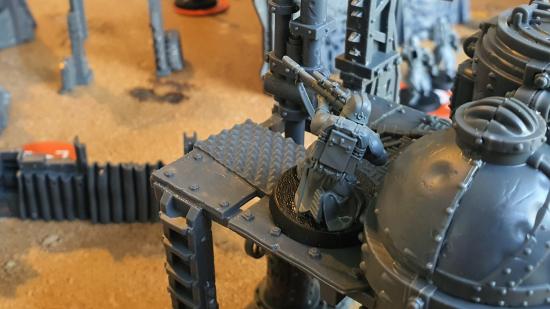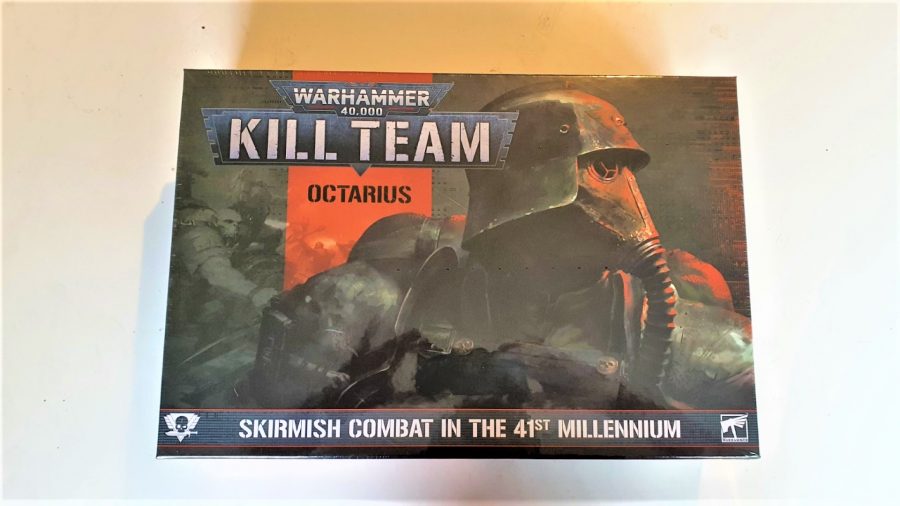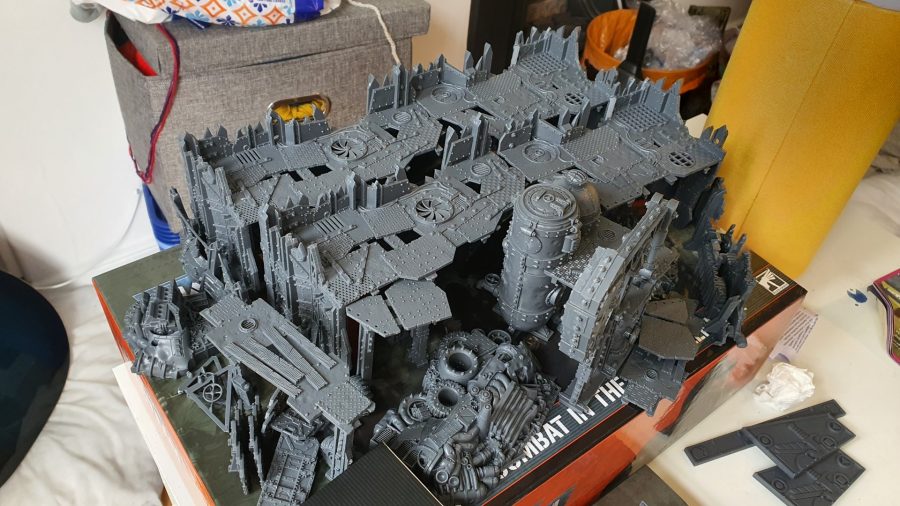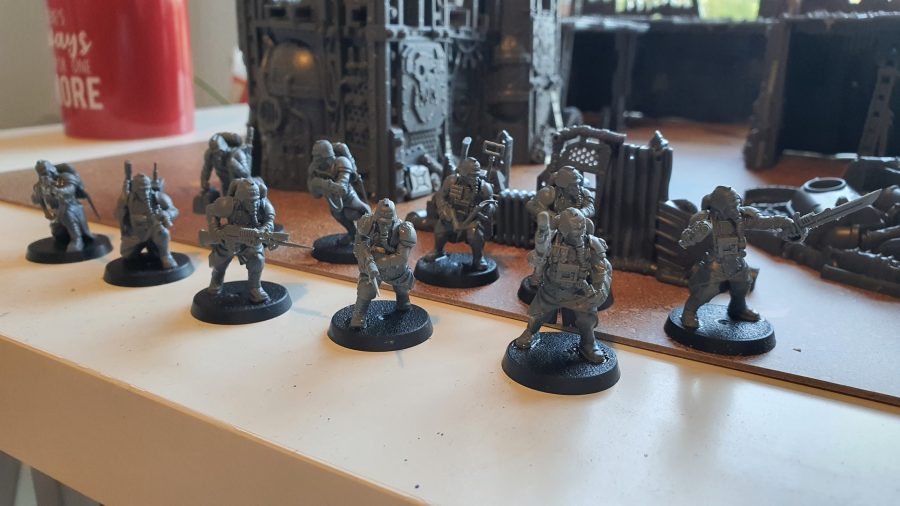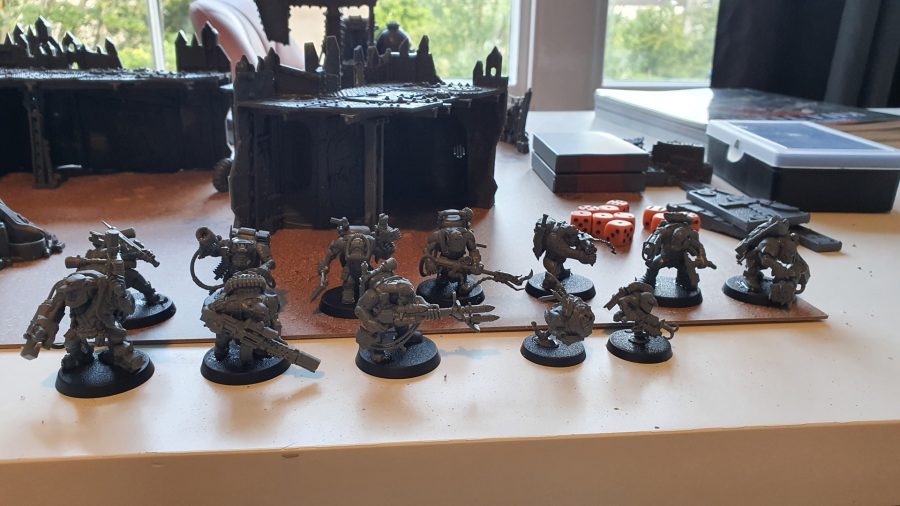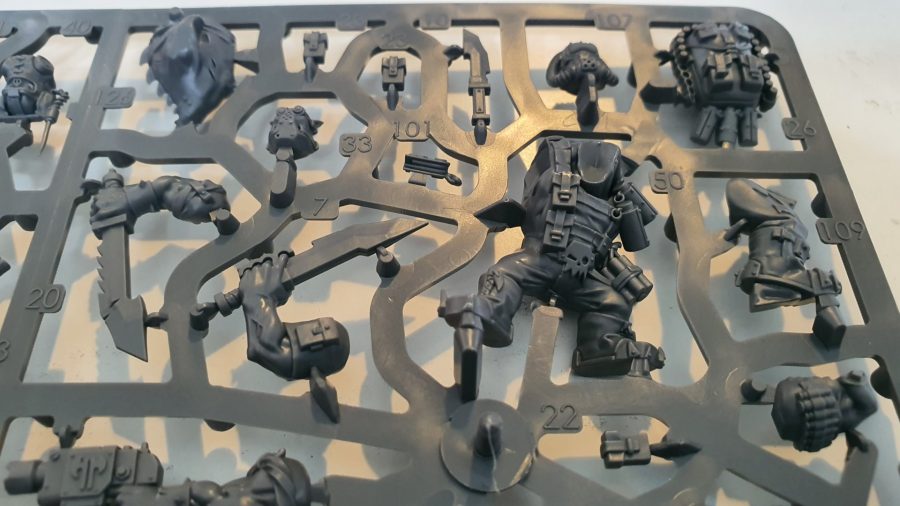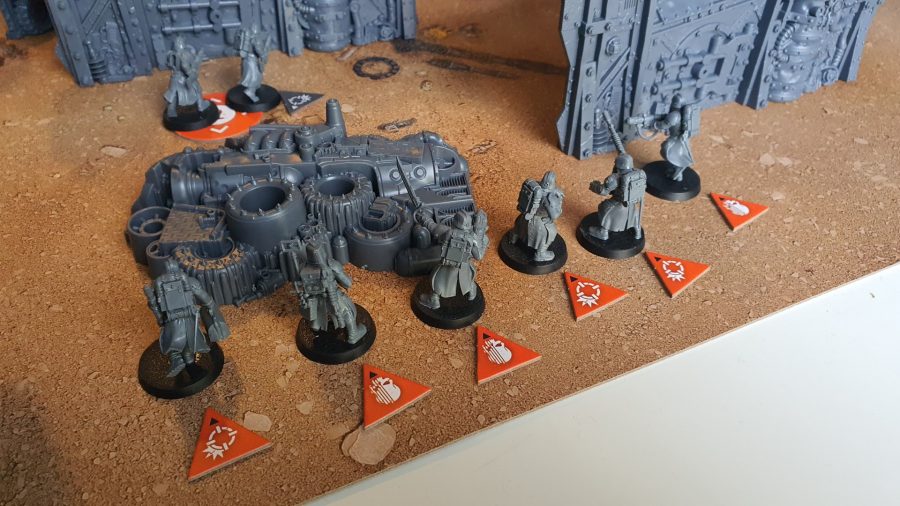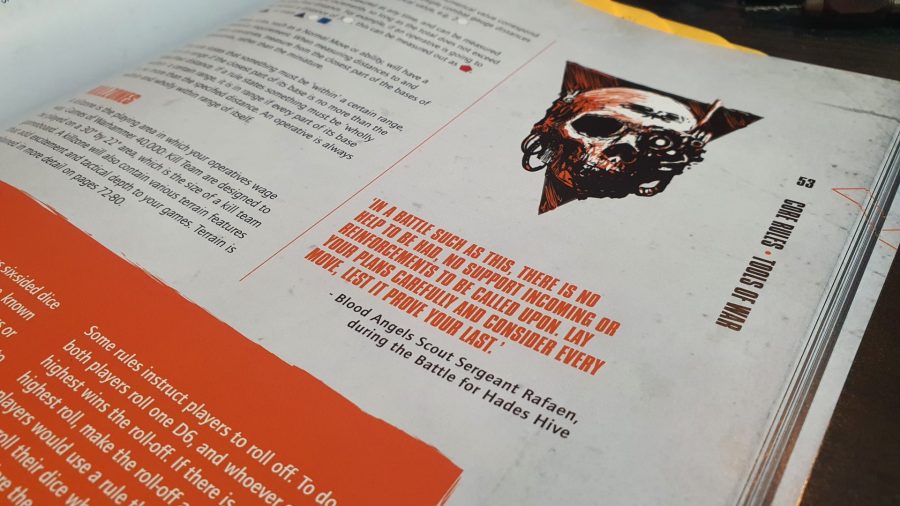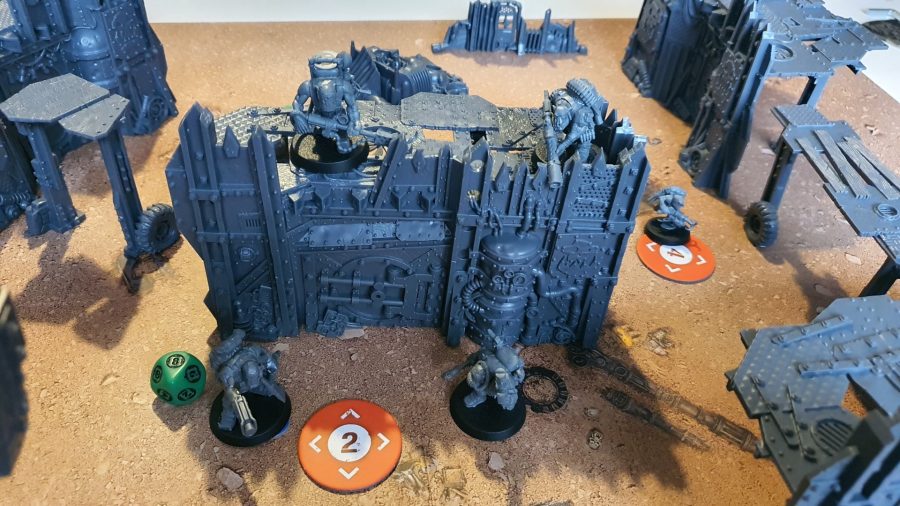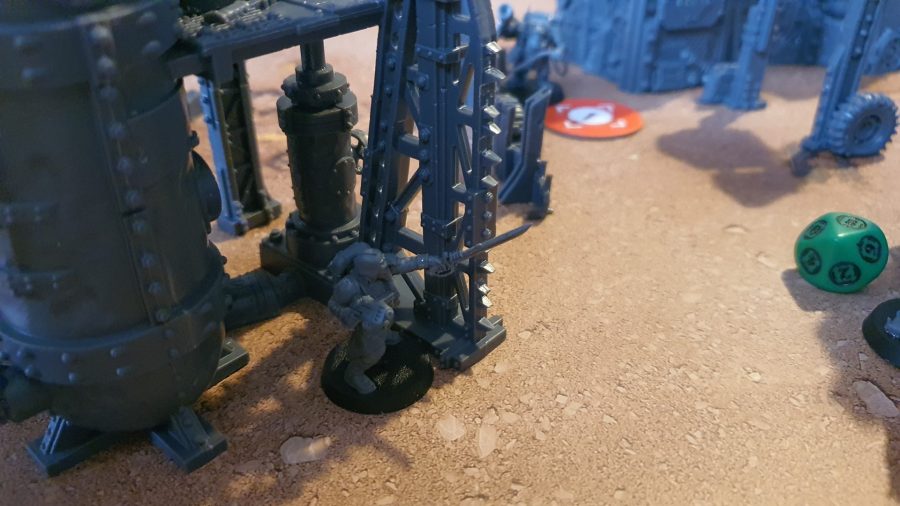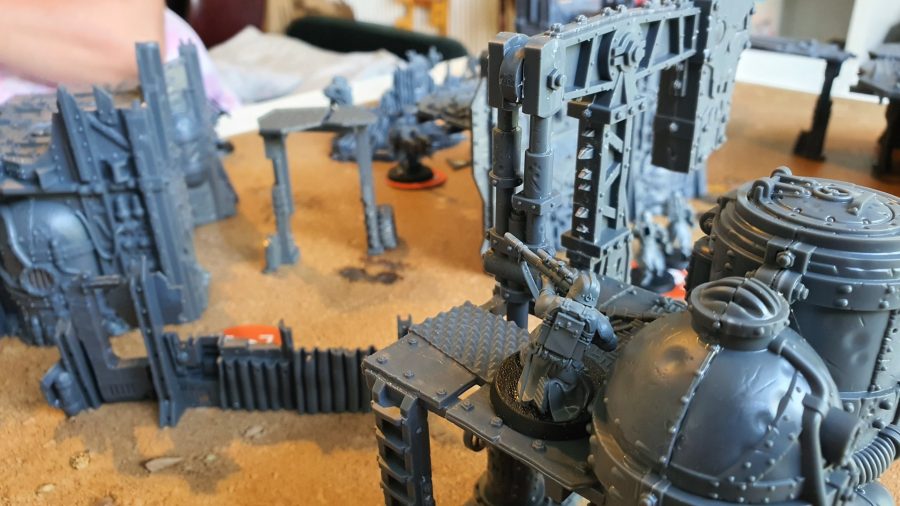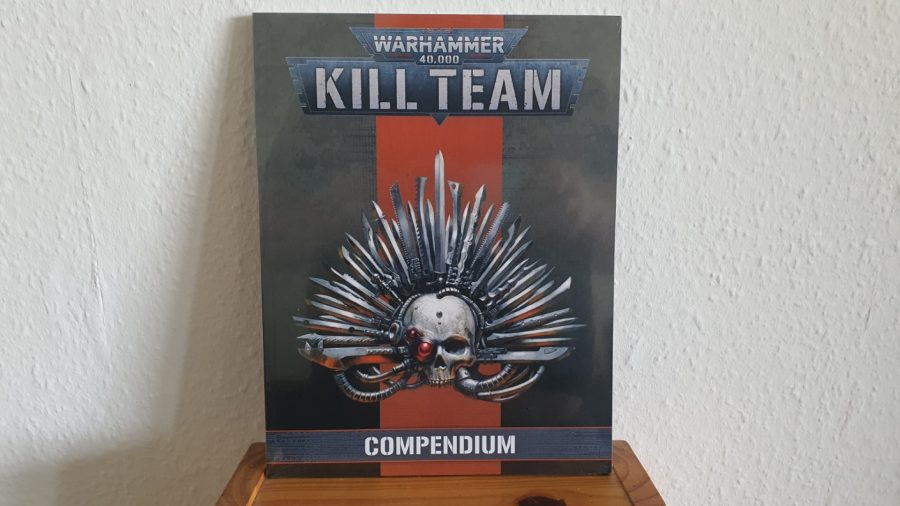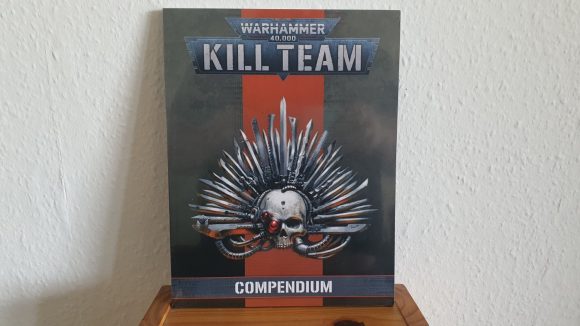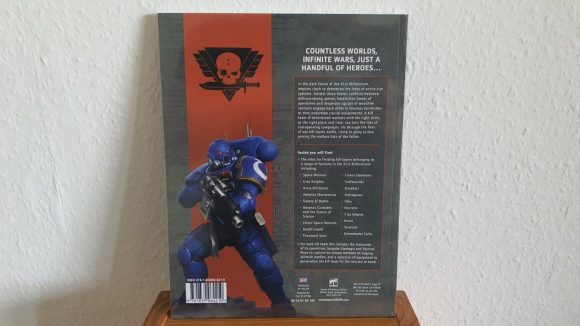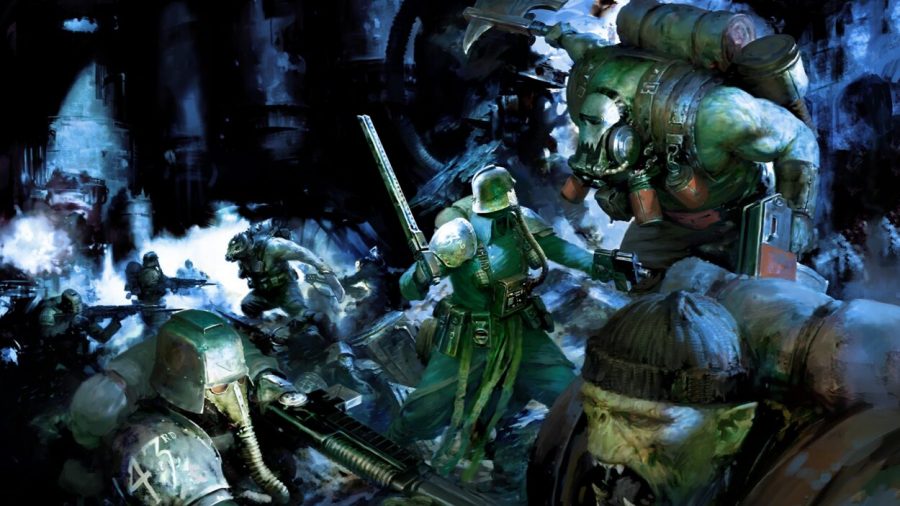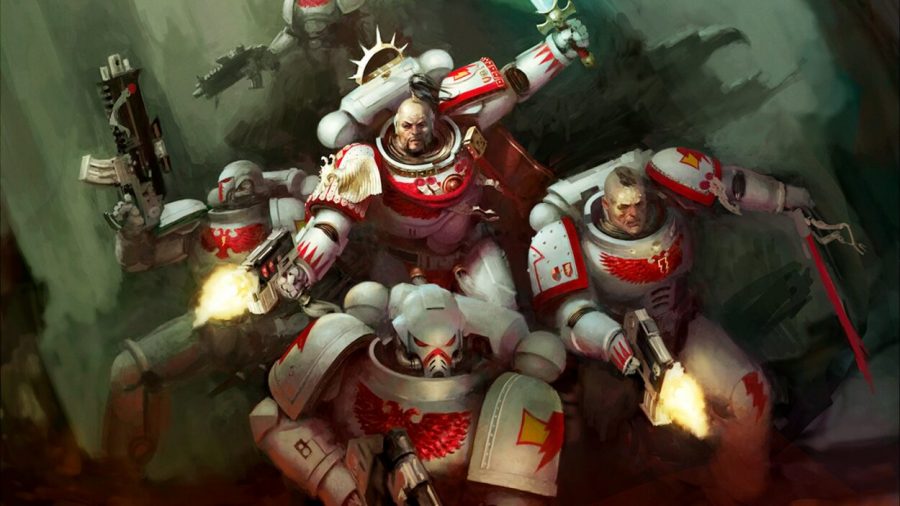I’ve been writing almost non-stop (or so it feels) about the new edition of Warhammer 40k: Kill Team for well over a month now, and it isn’t just because I really like the colour orange (honest). Games Workshop’s brand new version of Warhammer 40k’s scaled-down, skirmishing sibling has turned a lot of heads in the tabletop games world – partly due to GW’s textbook drip-feed of information about the new edition’s cunningly rebuilt ruleset, but also thanks to just how much of a surprise its announcement was to most of us.
With Kill Team’s previous (2018) iteration having somewhat faded into the background since the arrival of 40k’s 9th Edition in 2020 – and its latest expansion, Pariah Nexus, landing remarkably poorly among fans – we could be forgiven for having expected to see nothing from Kill Team for a fair old while, if ever. What few predicted was a full-on redesign and relaunch, with brand new rules (clearly inspired by Age of Sigmar’s parallel spin-off Warcry) and a massive, crowd-pleasing limited-edition box set to ring in the ‘new edition’. GW does like surprises, after all.
But what to make of this novel beast? How best to introduce and assess this new – and, honestly, quite bright – star in the Warhammer firmament? I’m going to break it down into three key parts: the Kill Team: Octarius launch box; the main game of Kill Team 2nd Edition itself, as laid out in the Core Book; and, finally, the somewhat controversial Kill Team: Compendium supplement, which provides new list-building rules for most Warhammer 40k factions.
When it comes to how Kill Team 2.0 actually works, I won’t further elongate this review by repeating the nuts and bolts of gameplay; you can learn all about its movement, shooting, fighting, list building, and more in our comprehensive Kill Team: Octarius guide.
Thankfully, though, GW has generously provided Wargamer with free review copies of both Octarius and the Compendium – so I can share my thoughts on how the thing turned out, who I think it’s for, and – ultimately – whether it’s any good. Since I’m a bluff old traditionalist, we’ll start at the beginning, with the big, brash, tangerine-coloured box of toys GW is using to fanfare its newest game.
Kill Team: Octarius – welcome to terrain town
Nab yourself a copy of Kill Team: Octarius (congratulations to those who got their pre-orders in early), and you’ll find the box itself is a treat for the eyes. The striking artwork, colour scheme, and general quality finish of this set is quite something, certainly the rival of its recent big-box forerunners Dominion and Warhammer Quest: Cursed City.
And so it bloody well should be, because it carries the same price tag. Octarius costs $199 / £125 from the GW webstore – the same price as the Age of Sigmar Dominion box the firm released in July – and yet, while Dominion contained a masterly 60 miniatures and a hefty hardback rulebook, Octarius includes just 23 toy soldiers in all, with a thinner, glossy softcover rulebook, and a slimmer-still Octarius supplement.
What makes up the difference, as it did with the original Kill Team starter set back in 2018, is a staggering amount of handsome, easy to assemble terrain. Back then, it was a cluster of ruined Imperial Cathedra; this time, it’s an Ork shanty town, so replete with ramshackle barricades and ramparts that you genuinely cannot use all of it in a game, because the dinky Kill Team board becomes too crowded. Rarely, with miniatures game starter sets, do you open the box and find yourself with more terrain than you need to play – but that’s what GW has pulled off here, underlining Kill Team’s focus on a close-up, detailed scale and atmosphere.
Here’s the terrain you get:
- Four Ramshackle Walls
- One Oil Pump
- Three Ramshackle Barricades
- Three Scrap Piles
- Six deployable small barricades
- Parts for two-three extra bits of raised gantry (for some reason not mentioned in the Octarius book or instructions)
And the other bits:
- 12 Ork Kommandos (Including a Nob, a Grot, and a Bomb Squig)
- Ten Death Korps of Krieg Veteran Guardsmen (and a med kit)
- Kill Team Core Book (144 pages) x 1
- Kill Team: Octarius supplement (96 pages) x1
- One 30 x 22 inch game board
- Sheet of cardboard tokens, including six objective markers
- Two sets of Tac Ops cards
- Two plastic movement gauges with one-inch, two-inch, and three-inch edges
- One six-inch measuring stick
- 12 matt orange six-sided dice
Sure, some of the terrain pieces aren’t brand new, but rather scrounged from 2018’s Speed Freeks boxed game, and yes, you’ll have to decide carefully whether, in the long run, a $199 box whose value is skewed heavily towards terrain is right for you.
The Lion’s Sons: Our guide to the Dark Angels Space Marines
But, for my part, as a Kill Team newbie, I found it refreshing to have everything required for a proper, furnished battle board right there in the starter box – as opposed to getting a boatload of brand new minis, only to have to do battle across bare, arid dining-room table, with only teapots and pepper grinders for cover.
Guard v. Greenskins
Do consider, as well, that those 23 miniatures are hardly unimpressive. GW grabbed attention quickly when its July 9 trailer for Kill Team: Octarius showed Death Korps of Krieg troopers battling Ork Kommandos – two quite famed units, for recently less-loved factions, which had never before received their own kit in plastic – and the final models most certainly do not disappoint.
The Death Korps of Krieg, for so long only available in expensive Forge World resin form (in two flavours: ‘standing’ and ‘running’), make for a much more flexible and interesting bunch of miniatures than I, for one, expected. Though still very much defined by their oppressive, grimdark visual concept, locked as they are inside WW1-style trench coats and gas masks, these models have a surprisingly wide selection of pose and equipment options to add individuality, and tie each trooper to the role you’ll give them within your Kill Team.
They can’t help but be upstaged by the outrageous Ork Kommandos, though. I’m not a particularly huge Greenskins stan, but, in the personality stakes, the greenskins blow the kriegers out of the water here, with an endlessly lip-curling smorgasbord of chunky weaponry, big yellin’ faces, and scrapyard couture that you can’t help but love. Give them Ali G-style luminous camouflage threads, and I’ll give you an extra point.
Both teams are fleshed out with highly appropriate in-game rules and abilities. Twice per game, the Veteran Guardsmen can call in their choice of four different off-map air or missile strikes, and their Sergeant can give an order each turn to buff all troopers within 6” (or ⬟, as it’s referred to in-game – see our guide for details).
The Orks don’t have the same firepower, but make up for it with greater numbers, beefier maximum wounds, and the Throat Slittas rule, which allows them to charge the enemy directly out of concealment.
Tombtacular: Read our guide to Warhammer 40k’s Necrons
In general, once the Kommandos get up in the Guardsmen’s faces, things swing in the Greenskins’ favour – and, when that happens, the gleeful melee mayhem these fellas can wreak will have them melting the heart of even inveterate Emperor-lovers like me.
In particular, I fell in a sympathetic kind of love with Octarius’ Bomb Squig – gazing, as it does, determinedly across the battlefield, hand grenades clutched in its fangs, dynamite hanging off every side, ready to give its all for the Waaagh! Humorous, yet horrifying and grotesque. Very 40k.
Octarian oddities
For all that charm, though, I found some unexpected aggravations while building and exploring Octarius’ acres of plastic loveliness.
Actually putting together those krazy Kommandos was as frustrating an experience as I’ve had assembling Warhammer models in a long time, with each model’s constituent parts apparently scattered at random across three medium-sized sprues. This was normal in GW’s bad old days – especially with large, bespoke sprues for boxed games – but other recent offerings like Dominion were so gloriously straightforward to build that this old-school, Where’s Wally-style search for parts really caught me off-guard here.
Also surprising to find, in this day and age, was a slight mismatch between some of the terrain component numbers on the sprue, and those in the printed instructions – as well as the discovery that Octarius contains a few extra little terrain pieces (scrap panels and vertical girders, configurable as two sorts of rickety gantries) that aren’t mentioned in the instructions at all. Small complaints, to be sure – but noticeable.
And, when time came to play, actually getting up to an engrossing pace proved quite difficult – partly because the Core Book could be a mite clearer about a couple of key rules (more on that shortly), but mostly because I spent so much game time flipping between pages in the Octarius supplement booklet, looking up the stats for different operatives as they came up.
This is a familiar experience for old hands at Warhammer 40k or Age of Sigmar – larger, slower games, where armies’ various units often have multiple rules or interactions to double check on most turns. But, amid Kill Team 2.0’s fast, reactive alternating activations, the constant passing back and forth of one shared book of unit stats gets immersion-breakingly annoying very quickly.
Ulfenkarn remains: Our review of Warhammer Quest: Cursed City
GW’s decision not to include a sheaf of handy datacards for each of the Kommando and Krieg operators (as it did with Dominion, and, significantly, Warcry’s original starter set) feels like a disappointing missed opportunity to bring people into Octarius’ gameplay quicker and easier. It’ll just add insult to injury if and when those datacards arrive later and are sold separately, too.
Still, after a couple of games, minor assembly niggles fade into insignificance – and the book-passing faff ceases to be a real concern, as you’ll have memorised most of the key bits and bobs for both Kill Teams by then. Octarius is, for the most part, a well put together, well presented starter set – and, once you settle into this game’s rhythm, you won’t mind so much about the stumbles along the way, because (spoiler) Kill Team 2.0 is a really good game.
Kill Team 2nd Edition – beautiful books and bespoke brilliance
First things first: the Kill Team 2nd Edition Core Book, and the Octarius supplement (both included in the Octarius box set) are a couple of the spiffiest-looking books GW has ever produced. Page layouts are nice and clear; punky, orange-white-black original artworks add Kill Team personality, without plastering every page; and cover pages for each section have a pleasantly sharp orange overlay, contrasting the colourful art behind. Book make eye feel nice.
The rules themselves are mostly easy to grasp, and well laid out, though afflicted at times with the over-worded, competitive-balance-minded legalese of all modern GW rules. One medium-sized fly in the ointment here is the Core Book’s rather confusing choice to introduce the necessity of Conceal and Engage orders (and of placing their respective tokens) several pages before it properly explains what they mean, or what their effects are. This relatively short set of info could easily have been included in a text box on the same page, saving a lot of searching time and, significantly, removing some of the considerable friction on the way into your first game.
As I said, I’ll not rehash all the rules and mechanics, as you can browse them in our Kill Team: Octarius guide. Suffice it to say that, from the perspective of a long-term 40k player with tastes skewed more toward storytelling and atmosphere than competition, Kill Team 2.0 is very promising indeed.
The alternating activations move quickly and fluidly, and the Strategic and Tactical Ploys, as a mini version of 40k’s much more expansive sets of stratagems, offer just enough extra in-game levers to pull, without cluttering up Kill Team’s more energetic, moment-to-moment turn-taking.
For all those worried about the dreaded movement symbols, hear this once and for all: moving models and range finding using the shape symbols and combat gauge is absolutely fine.
Swamp monsters: Read our review of Age of Sigmar: Dominion
Sometimes, I found myself double checking which shape was which, or accidentally measuring a square instead of a circle. Woe is me. Other times, I was blessing the movement gauge for allowing me to comfortably measure zig-zagging moves around closely placed terrain, where no tape measure could easily go.
Never did I find it a particular annoyance or hindrance to play. It’s just not that big a deal, you guys.
Tac Ops, on the other hand, while I haven’t had much time to play with most of them, are a particular stroke of genius, splicing the previous Kill Team’s objectives system with 9th Edition 40k’s wildly popular secondary objectives to add variety and narrative colour to your game plan. Flipping a secret one after you’ve achieved it, as I remarked when they were first announced, really does feel like activating a Trap Card in Yu-Gi-Oh, and that’s a special thing in a wargame.
The three main ways to play – Open Play, Matched Play, and Narrative Play (in the form of the new Spec Ops campaign mode) – are, blessedly, presented very clearly with their individual characteristics, play instructions, and scenarios to try out. Having a dead-simple Open Play scenario for beginners to jump straight into is an especially welcome addition – although, for this rather involved skirmish game to be truly beginner friendly, it really needs a free, one-page quick start rules PDF. Don’t hold your breath on that one, though.
Matched Play will, no doubt, quickly dominate the conversation after launch, as players debate how the Kommandos, Kriegers, and all the many army lists from the Compendium compare with one another competitively. But the big, buffed-up Spec Ops narrative play mode is the stand-out feature in my mind. I’ve not had the chance to absorb its every delicious option yet, but this persistent campaign system – obviously built from the same materials as Warhammer 40k 9th Edition’s Crusade mode – is pregnant with potential for fantastic emergent storytelling.
Through a Spec Ops campaign, individual members of your Kill Team choose one of four classes (Combat, Staunch, Marksman, and Scout), gain XP, rank up, gain Battle Scars and Battle Honours, requisition equipment, and pursue sequential story missions together. And they’ll do it all from your personal Base of Operations – to which you’ll bring back rare weaponry as loot after hard-won missions.
It’s exciting stuff, and perfectly attuned to the zoomed-in perspective of Kill Team, where the lives – and therefore the names, skills, and backgrounds – of each individual operative weigh much heavier on the scales.
We march for Macragge: Read our guide to the Ultramarines
There is, truly, a lot of excellent potential packed into this Core Book – but frankly, there had better be, because it’s a 144-page softback rulebook that, on its own, costs a hefty $50 / £30.
More worryingly still, unless you manage to snap up Kill Team: Octarius, with its built-in Kill Teams and rules, that $50 Core Book still won’t, on its own, allow you to start playing. For that, you need a second book – and that’s where things get a bit uglier.
Kill Team: Compendium Supplement – a rocky road in
Apart from all that funny business about the movement gauges and symbols, there’s one other major source of consternation among would-be fans of the new Kill Team, and, as is so often the case with Warhammer, it’s about rulebooks and pricing.
In the previous, 2018 edition of Kill Team, the core rulebook (then, as now, included in the limited edition starter box) contained rules and points values for forming kill teams from nearly all 40k’s Imperium, Chaos, and Xenos armies. It ran to a princely 208 pages, with well over 100 of those taken up with datacards, tactics, name tables, and points values. This meant that, if you already had a collection of miniatures, all you needed to start playing Kill Team was that one book. Some of the rules might have been more barebones than others, but it was all there, in one package.
This time around, the $50 Core Book doesn’t have that wealth of faction rules. In fact, the new Core Book contains no Kill Team list-building rules at all, for any factions. The rules for the Veteran Guardsmen and Ork Kommandos appear only in the Octarius box’s special supplement (not, at print time, planned to be sold separately), while all the other factions’ rules can only be found in the new, separate Kill Team: Compendium book – which will cost you another $60 / £30.
That effectively means that, Octarius aside, for existing Warhammer collectors and players, this edition of Kill Team is twice as expensive to start as its predecessor was in 2018. Meanwhile, if you’re a prospective new Warhammerist intrigued by the new Kill Team, but don’t own any models yet, it’s even pricier, as you’ll have to buy:
- A box of Troops models for each Kill Team (around ~$35 / ~£23 each)
- The Core Book ($50 / £30)
- The Compendium ($50 / £30)
The increased buy-in cost isn’t the only complaint, either. As a few other reviewers (including everyone’s favourite soothing-voiced nerdy YouTube uncle, Tabletop Minions’ Atom Smasher), have remarked, the list-building rules in the Compendium not only appear pretty light on Abilities and Unique Actions (which help give distinct, meaningful in-game roles to the various different operators), but also leave many factions very limited in the variety of models they can field at once.
Ancient aliens: Read our guide to the Eldar Craftworlds
In the previous edition, each individual model had a points cost, and Kill Teams could mix and match models fairly freely, within a given points budget. By contrast, in the new Kill Team: Compendium – where points costs have been axed, in favour of picking models from pre-structured quotas – most of the various factions’ listed Fireteam options can only have one type of model in them.
And, since no faction’s Kill Team can consist of more than two Fireteams, this means quite a few of the currently available Kill Team configurations can simply only have one or two types of miniatures in them. Space Marines, who can only have one Fireteam, are especially hit by this homogenising effect.
The Compendium, therefore, is also a bummer for long-time Kill Team fans with lovingly built, storied Teams on their shelves, made up of three or four distinct types of dude. That goes double if those dudes include Elites and HQ character models – both of which were introduced into the previous edition via expansion sets, and neither of which are included in the new game at launch.
Combined, these issues have stoked up the (always smouldering) fires of fan anger about how GW packages out rules content. And, while the Compendium does actually offer a fair stack of cool-looking faction specific Strategic and Tactical Ploys, Equipment options, and more, to give your Grey Knights, Tau, or Death Guard Kill Teams flavour – I can’t help but notice there’s also an awful lot of blank space among its dozens of pages of phat datacards – each of which takes up the same half-page slot, regardless of whether it has several special rules to fit in, or none at all. GW’s reasons are its own, but it’s hard not to feel that all this could have been fit into one book – easing the burden on players new and old – without harming revenue too much.
Still, such drawbacks are temporary; as Atom Smasher rightly notes, the Compendium is obviously a “stopgap” solution to make all factions playable in Kill Team 2.0 – analogous to the Index books released at the beginning of Warhammer 40k 8th Edition – and successive factions will inevitably receive more in-depth rules alongside the promised “conveyor belt” of new Kill Teams scheduled to release quarterly (with those poor, hard-done-by Space Marines at the front of the queue, no doubt).
All of which, to me, makes the question of how to approach Kill Team 2nd Edition something of a no-brainer, for a new player at least: if you can get hold of Octarius, and you’re tempted by the new edition, go for it. I can wholly recommend it as a complete game-in-a-box, and a highly enjoyable introduction to the new game.
On the other hand, new player or old, if you can’t snag an Octarius box (and you’re not enough of an eager beaver to burn $50 on 19 different factions’ worth of basic rules), it’s probably worth hanging fire on the game until we know more about the forthcoming new Kill Teams, or possible expansions – any one of which might make a better entry point for you.
The current releases roadmap suggests we can expect, at a minimum, two new Kill Teams every three months until next June, with all the rules and accoutrements they bring – so keep an eye out, and you might strike lucky with dedicated rules and models for your favourite army soon enough.
Cybernetica: Check out our guide to 40k’s Adeptus Mechanicus
Whichever route you choose, this new edition, as a whole, feels like a positive step for Kill Team. Where many had thought it would die out, GW has instead invested much in rebooting it, hard, with a genuinely top-class starter box, and a cracking ruleset with vast potential.
Being asked to buy two books instead of one at the beginning of this new edition, and/or wait an unknown amount of time for your faction to get better stuff, may leave a sour taste in your mouth, but hey – Warhammer 40k players have to do it all the time, and it doesn’t do us any harm. Probably.
Now, if only I knew how to get hold of enough Leadbelcher spray to paint all the damned scenery…
